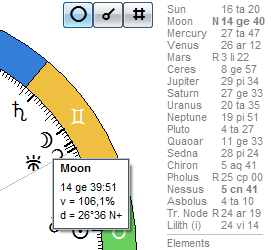
| What Watch? - Tutorial | Next chapter: Synastry, Composite, Davison | Back to First Page |
Declination
When we speak of a planetary position in the zodiac, we already have simplified a good deal: we pretend that all planets move on the exact same rotational disk – but that's not true. The orbital planes of the planets are inclined to each other, every one a little differently. If you look at it from the surface of the earth, you get an even more oblique image: depending on the seasons, you'll see the planets' paths in different positions above the horizon. Of course, this is because the earth's axis is tilted about 23°26' against the path of the Sun, the ecliptic. At a winter noon, the sun is up to 23°26' lower than during the equinoxes, and in summer, it is up to 23°26' higher. So, on the northern hemisphere, the difference is 23°26N at the summer solstice, and 23°26S at the winter solstice. These values are the "declination" of a planet.
 |
In What Watch, you'll find declination in many places. Let's take Sigmund Freud as an example (you'll find his birth data in the data directory of What Watch). When you point on the Moon with the mouse, the information pictured on the left is shown: exact position in the zodiac, relative speed (the Moon is here faster than usual) and the declination: 26°36' N. This value is remarkable, because it is beyond the limits the Sun can reach: 23°26' is its maximum declination. The Moon, at Sigmund Freud's time of birth, is travelling beyond the Sun, it is "out of bounds". As you see on the left, planets "out of bounds" are marked by What Watch with a "+", in the planet list on the right they are shown in bold letters. |
You can also see the declination values of all planets on the data tab. Click on the table with the zodiac positions: you'll get the data for declination and speed (in degrees per day). On the data tab, planets "out of bounds" are marked with inverted commas: 14'ge'40 in the case of Sigmund Freud.
In the transit lists declinations are used as well: you'll find the dates when a planet gets out of bounds and when it reenters the Sun's realm.
Literature:
Paul F. Newman – Declination in Astrology, The Wessex Astrologer, Bournemouth 2006 (a short introduction by the author is available at
www.astrologer.com)
Steven Forrest – The Moon Out Of Bounds,
www.forrestastrology.com
| What Watch? - Tutorial | Next chapter: Synastry, Composite, Davison | Back to First Page |